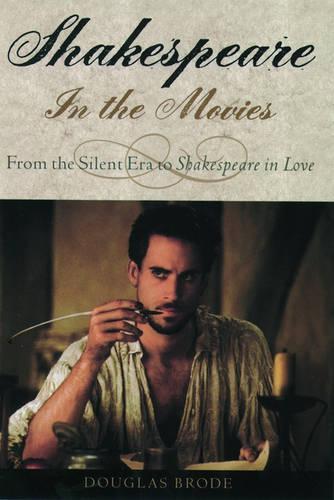Overview
Shakespeare is now enjoying perhaps his most glorious--certainly his most popular--filmic incarnation. Indeed, the Bard has been splashed across the big screen to great effect in recent adaptations of Hamlet, Henry V, Othello, Twelfth Night, Romeo and Juliet, Much Ado About Nothing, Richard II, A Midsummer Night's Dream, and of course in the hugely successful Shakespeare in Love. Unlike previous studies of Shakespeare's cinematic history, Shakespeare in the Movies proceeds chronologically, in the order that plays were written, allowing the reader to trace the development of Shakespeare as an author--and an auteur--and to see how the changing cultural climate of the Elizabethans flowered into film centuries later. Prolific film writer Douglas Brode provides historical background, production details, contemporary critical reactions, and his own incisive analysis, covering everything from the acting of Marlon Brando, Laurence Olivier, Richard Burton, and Gwyneth Paltrow, to the direction of Orson Welles, Kenneth Branagh, and others. Brode also considers the many films which, though not strict adaptations, contain significant Shakespearean content, such as West Side Story and Kurosawa's Ran and Throne of Blood. Nor does Brode ignore the ignoble treatment the master has sometimes received. We learn, for instance, that the 1929 version of The Taming of the Shrew (which featured the eyebrow-raising writing credit: ""By William Shakespeare, with additional dialogue by Sam Taylor""), opens not so trippingly on the tongue--PETRUCHIO: ""Howdy Kate."" KATE: ""Katherine to you, mug."" For anyone wishing to cast a backward glance over the poet's film career and to better understand his current big-screen popularity, Shakespeare in the Movies is a delightful and definitive guide.
Full Product Details
Author: Douglas Brode (Professor of Film, S.I. Newhouse School of Public Communication, Professor of Film, S.I. Newhouse School of Public Communication, Syracuse University)
Publisher: Oxford University Press Inc
Imprint: Oxford University Press Inc
Dimensions:
Width: 23.60cm
, Height: 2.60cm
, Length: 16.50cm
Weight: 0.513kg
ISBN: 9780195139587
ISBN 10: 0195139585
Pages: 272
Publication Date: 20 April 2000
Audience:
Professional and scholarly
,
Professional & Vocational
Format: Hardback
Publisher's Status: Active
Availability: To order

Stock availability from the supplier is unknown. We will order it for you and ship this item to you once it is received by us.
Reviews
"""Brode gives vivid descriptions of the various movies that have been made of [Shakespeare's plays], weaving together the historical circumstances in which Shakespeare actually worked with a look at the circumstances in which the films were made- a Soviet Othello, for instance, or a King Lear by Jean-Luc Godard.""--Publishers Weekly ""This princely volume conveys the fun of both Shakespeare and film analysis. If contemporary cinema studies often prove as challenging as Elizabethan blank verse, prolific film writer Brode is accessible. He offers historical background, production details, information on critical response, and trenchant analysis. All libraries should consider for purchase.""--Library Journal ""From the Globe to the multiplex, this exhaustive study leaves no stone unturned.""--Kirkus ""Douglas C. Brode...wittily traces the history of the Bard on celluloid...Brode doesn't simply annotate a chronological list of movies about Shakespeare. Instead he looks at the treatment of each play during the movie-drenched 20th century.""--www.bookpage.com ""An entertaining and quite insightful review of the history of this fascination and adaptation, with considerable selected information about the film-makers and actors that have figured in the production of these films. The account is engaging, the details are fascinating, the analysis is perceptive."" Virginia Quarterly Review"
A critical analysis of (almost) every American film based on a Shakespeare play. Brode (Cinema/Syracuse Univ.; The Films of Robert De Niro, not reviewed, etc.) here assesses everything from the acting of Marion Brando (Marc Anthony in a 1953 Julius Caesar) and the directing of Orson Welles (Othello, 1952, and Macbeth, 1948) to the Shakespearean content of adaptations like West Side Story (1961). Brode organizes his narrative by individual plays (or linked groups of plays) rather than in chronological order, which means readers must wade through many pages about better-forgotten productions before arriving at the flicks we know and consider good Shakespeare. We learn that there was a 12-minute nickelodeon version of The Taming of the Shrew, and that Mack Sennett's famous Keystone Cops routines owe a debt to the scene with Petruchio's servants in the first serious cinematic treatment of this play (1908). Like the original productions at the Globe Theatre, Shakespearean movies have always been popular, Brode points out. The Bard's structure, involving many short scenes, is well suited for film, and apparitions like Hamlet's ghost anticipated Hollywood's special effects. Old Will would have loved the movies, beamed Welles. For most productions, Brode cites critical reactions, including those of purists who didn't approve of filming the plays at all. He's not shy with his own opinions either: a typically bold assessment is that [Sidney] Poitier cheated himself, and us, of an important work by not playing Othello. Sorry, Shakespeare in Love is too recent to be discussed here. From the Globe to the multiplex, this exhaustive study leaves no stone unturned - and there's the rub. A sizable fraction of Brode's study will be of interest only to film historians. (Kirkus Reviews)
He [Brode] includes a substantial number of foreign films, thus departing from the current tendency to focus on mainstream films in English. Years Work in English Studies Clear and opinionated about interpretations and performances. Sixteenth Century Journal
He [Brode] includes a substantial number of foreign films, thus departing from the current tendency to focus on mainstream films in English. Years Work in English Studies Clear and opinionated about interpretations and performances. Sixteenth Century Journal
Author Information
Douglas Brode is Professor of Film at S.I. Newhouse School of Public Communication, Syracuse University and the author of eighteen books, including Money, Women, and Guns: Crime Movies from Bonnie and Clyde to the Present, The Films of the Eighties, and From Walt to Woodstock: How Disney Created the Counter-Culture, (forthcoming from OUP).




